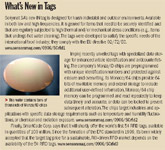Investments Yield RFID Progress
It's clear that developers see RFID-and-sensor networks as a key growth area. A sampling of recent developments in tags (sidebar) and infrastructure prove it.
 What s New in Tags |
For instance, Sun Microsystems says it combined its RFID Test Center with its Advanced Product Testing (APT) environmental test laboratory to meet growing demands of customers to test multivendor RFID and sensor products for their ability to withstand extreme conditions such as excessive heat and cold, shock, humidity, vibration, altitude, and pressure. Sun says the new facility, called the Sun Advanced Product Testing Lab for RFID and Sensors, is the world's first to combine industrial-strength environmental-stress testing with comprehensive interoperability and standards-compliance testing.
 |
The RFID Test Center helped customers implement comprehensive, interoperable RFID systems that meet industry standards and mandates, says Jim Del Rossi, facility director. Combining it with the APT lab lets customers conduct real-world, industrial-strength tests relevant for military, shipping, aerospace, medical, and other settings. www.sensorsmag.com/0906/SCrfid4
Additionally, Sun recently launched the first RFID and sensor-based Java.Net community Web site for Java developers at http://sun.java.net/rfid-sensors. The site gives access to a community of expert colleagues; information and product demos; free RFID software, toolkits, and sample source; and other resources for creating RFID and sensor-based products, applications, and services. www.sensorsmag.com/0906/SCrfid5
AT&T Inc. and its subsidiary, Sterling Commerce, are partnering with Intel, BEA Systems, and Symbol Technologies to design and deploy RFID device services and networks. They wish to offer businesses a best-of-breed managed RFID service and to standardize RFID technology by accelerating mass adoption through the evolution to universal sensor networks.
The partners are working to incorporate end-to-end services for RFID networks across diverse hardware platforms, operating systems, applications, and databases. This is a major challenge confronting RFID technology today.
"As RFID becomes more widely deployed, network reliability, security, and data integrity become increasingly critical," says Eric Shepcaro, senior vice president of business development at AT&T. "And for most companies, the task of ensuring those three things will be overwhelming and complex, especially across multiple hardware platforms and configurations and diverse supplier and partner networks and databases."
AT&T says RFID represents its initial offering in universal sensor networks. The company is collaborating with industry leaders to develop location-based services, wired and wireless tracking, and specialized network applications. www.sensorsmag.com/0906/SCrfid6
G2 Microsystems Inc. has developed a device provider for Microsoft BizTalk RFID. It enables ultra-low-power devices to sense and report data through a WiFi access point to Microsoft BizTalk RFID—thus leveraging ubiquitous WiFi and Windows technologies.
G2's ultra-low-power system on a chip (SoC) integrates WiFi with RFID technology and sensors, allowing battery-backed devices to sense and report for up to five years with no incremental infrastructure cost. Microsoft BizTalk RFID provides device abstraction, data filtering, and event handling while allowing G2-based tags to transmit sensor data through the widely deployed WiFi (IEEE 802.11) network infrastructure to the BizTalk RFID. www.sensorsmag.com/0906/SCrfid7
Biometric Sensors Combined
The National Institute of Standards and Technology (NIST) offers the Multimodal Biometric Application Resource Kit (MBARK), a new standardized middleware package to help you combine various types of biometric sensors from different manufacturers into one application. www.sensorsmag.com/0906/SCbio
Fighting Fire with Sensors
One of the things the FDNY learned during the crisis of 9/11 is the importance of coordinating emergency vehicles without delay," says Asa Yanai, project manager for Motorola, which supplies vehicle-tracking systems to the New York and Chicago fire departments. The company's MDR800 model F5127 system integrates a u-blox GPS receiver with dead-reckoning functionality that, aided by other sensors, provides accurate vehicle location information—even in tunnels and underground parking garages. The systems are responsible, say New York City officials, for reducing response time to 911 calls by 3 minutes. www.sensorsmag.com/0906/SCfire1
The results of a study—made possible by another sensor system—can help ensure the safety of firefighters once they arrive on the scene.
Because firefighters work at or near maximal heart rates for extended periods while training, the experience is dangerous—and too often deadly. So Maryland Fire and Rescue Institute (MFRI) and The Center for Firefighter Safety Research and Development conducted a year-long scientific study to determine guidelines for firefighter training safety—with the help of VivoMetrics LifeShirt.
Worn beneath protective gear, the LifeShirt enabled MFRI to monitor respiration, ECG, blood oxygen saturation, temperature, and activity level during standard training exercises, including maze crawls, 1000° F fires, and hose pulls—conditions that cannot be replicated in a laboratory environment. "Until now, there was no other way to measure firefighters' life-signs in real-time, during training," says MFRI director Steve Edwards.
The LifeShirt-informed guidelines were presented to fire departments and training academies nationwide last month. www.sensorsmag.com/0906/SCfire2
Eyes on NH Roads
The Portsmouth Herald reports that the NH department of transportation has begun deploying sensors to measure atmospheric and road-surface conditions. Scientists at the University of New Hampshire are also using the weather towers to house ozone sensors to detect and measure air pollutants. Data gathered by the sensors allow the state to better plan winter maintenance.
www.sensorsmag.com/0906/SCroads
Coolest Toy of the Year
BusinessWeek called the Lego Mindstorms NXT kit, which debuted July 31, "probably the smartest, coolest toy of the year . . . a great way to learn the basics of mechanics, physics and computer programming, or just goof off." The kit includes an ultrasonic sensor that measures distance within an inch; a microphone that measures sound to within the decibel; a touch sensor; and a light sensor that shines a beam to determine the reflectivity of an object or measure room brightness. www.sensorsmag.com/0906/SClego